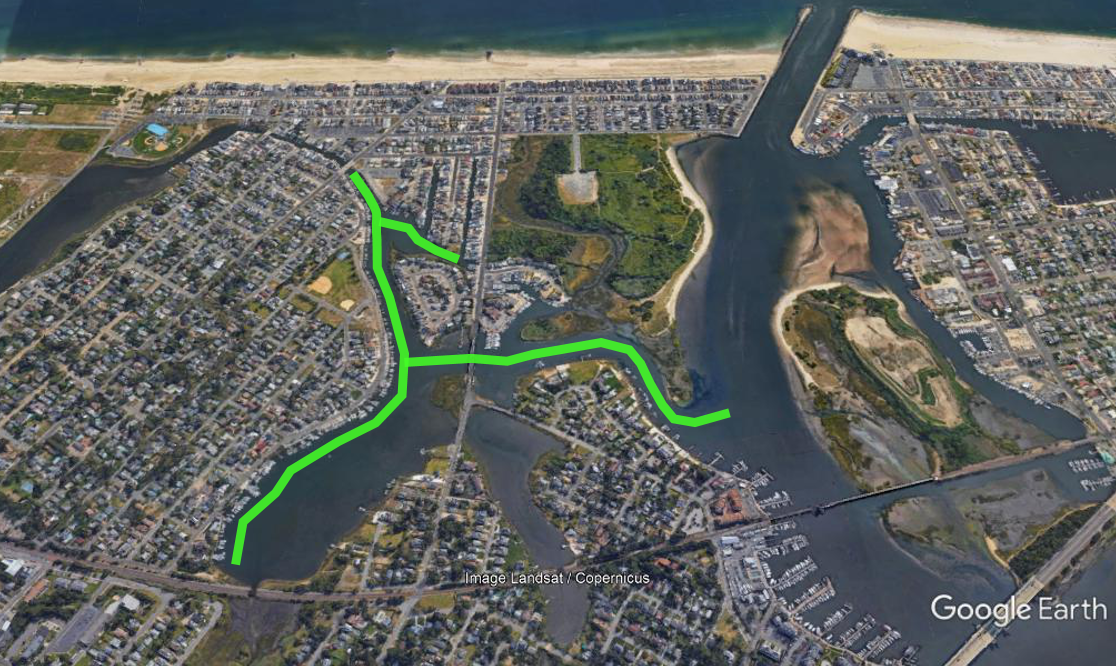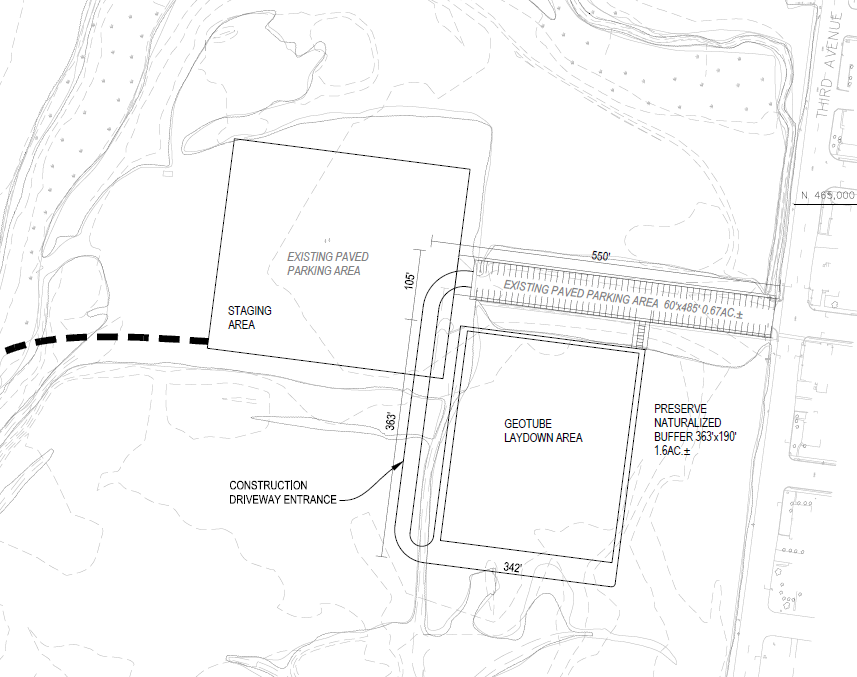Dredging

Fall 2021-Spring 2022 DOT/Monmouth County Dredge Project
Dredge Area in Above in Green
New Parking Lot Schematic Below
Dredging to Replenish Fisherman's Cove Beach and to restore Manasquan boating waterways commencing July of 2021 and concluding prior to Memorial Day, 2022
UPDATED: September 27, 2021
- NJ DOT’s contractor for the project, H&L Contracting LLC., completed dredging of Wills Hole Thorofare and the refurbishment of Monmouth County’s Fisherman’s Cove beach (“dog beach”) in August, 2021.
- During the last week of September, the contractor will begin clearing the foliage necessary for the construction of the new County-owned beach over-flow parking lot which will be situated directly to the south of and adjacent to the current paved Pompano parking lot (this will allow the County to begin the restoration of the existing over-flow parking lot, west of the paved Pompano lot, to natural habitat).
- This parking lot will be separated from 3rd Avenue by a 190’ natural buffer.
- This new parking lot will serve as the staging area for the dewatering geo-thermal bags for the duration of the project.
- Dredging of the Manasquan state channels, Glimmer Glass, Watson’s Creek, Sherman’s Creek and Deep Creek will commence during the latter part of October. Dredge material will be pumped into geothermal bags which will be staged in the new parking lot to allow for dewatering.
- Dredging will continue 24/7, 7 days per week until the end of December. Thereafter the material shall remain in the geo-bags to dewater.
- Starting in February, 2022 and continuing into May of 2022, the dewatered material will be loaded into trucks and transported to the Monmouth County Reclamation Center, Tinton Falls to be used for cap and fill.

- Additional Logistics:
- A temporary construction driveway entrance into Fisherman’s Cove will be created across from Salmon Ave. and will be removed once it is no longer
necessary for the project.
- Temporary striping, signage and the removal of several parking spaces on 3rd Ave. will be necessary in the vicinity of the Salmon Ave. construction entrance.
- Some lighting of the dewatering site will be necessary during nighttime hours. Precautions will be taken to ensure the lighting poses no inconvenience to surrounding neighbors.
Click Here for Full Press Release
Dredging Benefits
Manasquan is a community with over 6 miles of tidal coastline. Maintenance of its waterways is of critical importance to the Borough. Sediment dredging protects recreational and commercial use of our waterways and supports a healthy maritime ecosystem. An additional benefit of dredging is realized when environmentally acceptable dredged material is transferred to area beaches to build up the beach berm. The berm is the front-line defense against beach erosion caused by hurricane, tropical storm and nor'easter wave action. In fact, during a 2017 dredging operation the dredged material was successfully and effectively used to improve the Manasquan beach berm.
Flood Mitigation - A Common Misconception
One common misconception about dredging is that it mediates or even protects against coastal flooding and/or storm surge. Manasquan's waterways are tidal and connected to the Atlantic Ocean. This connection is the primary driver for coastal flooding. Simply put, no matter how deeply dredged a tidal waterway may be, even at low tide, the additional capacity created by dredging is already full prior to any storm. Because of this, flood attenuation remains unchanged despite the depth of the channel.
Government Waterway Dredging
There are several government agencies that engage in dredging including the US Army Corps of Engineers (Army Corps) and the NJ Department of Transportation (NJDOT). The Army Corps is responsible for maintaining federal navigable waterways. Examples of such waterways include the Manasquan Inlet and the 3,000-mile long Intracoastal Waterway which includes portions of the Manasquan River. Locally, the Army Corps regularly deploys a dredge/barge nick-named the "Currituck" to survey and dredge the Manasquan Inlet (see the area highlighted in red above). NJDOT is responsible for maintaining state navigable waterways, such as Crabtown Creek, which connects the Glimmerglass to the Manasquan River. In 2017, Manasquan partnered with the NJDOT to dredge Crabtown creek and other area waterways (see area highlighted in green above). Over 40,000 cubic yards of sand from this project were delivered to vulnerable areas along the beachfront berm to provide additional coastal and storm surge protection. Also in 2017, the Borough removed material from the municipal marina boat slips during renovation in the area of Perrine Boulevard (see area highlighted in blue above). Some of the material dredged from this area was utilized as cap fill at the Monmouth County Reclamation Center via a shared service agreement.
Going Forward
Manasquan is actively exploring opportunities to continue its efforts to maintain and improve its waterways. Dredging is an expensive and complex undertaking. Issues such as extensive planning, complex permitting, environmental testing and material handling all must be considered. As an example of the expense involved, it is currently estimated that the cost to dredge and dispose of three feet of material from Stockton Lake could cost up to $10 million. The governing body is currently studying successful dredging initiatives undertaken in other jurisdictions and researching the availability of grant funding and possible cost-sharing opportunities with state and federal agencies.

